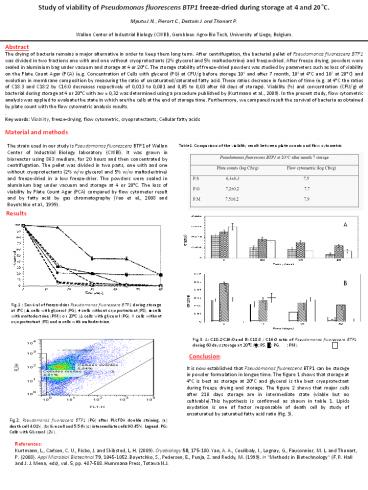Diapositive 1 - PowerPoint PPT Presentation
1 / 1
Title: Diapositive 1
1
Study of viability of Pseudomonas fluorescens
BTP1 freeze-dried during storage at 4 and
20C. Mputu J.N., Pierart C., Destain J. and
Thonart P. Wallon Center of Industrial Biology
(CWBI), Gembloux Agro-Bio Tech, University of
Liege, Belgium.
Abstract The drying of bacteria remains a major
alternative in order to keep them long term.
After centrifugation, the bacterial pellet of
Pseudomonas fluorescens BTP1 was divided in two
fractions one with and one without
cryoprotectants (2 glycerol and 5
maltodextrine) and freeze-dried. After freeze
drying, powders were sealed in aluminium bag
under vacuum and storage at 4 or 20C. The
storage stability of freeze-dried powders was
studied by parameters such as loss of viability
on the Plate Count Agar (PCA) (e.g. Concentration
of Cells with glycerol (PG) at CFU/g before
storage 109 and after 7 month, 108 at 4C and 107
at 20C) and evolution in membrane composition by
measuring the ratio of unsaturated/saturated
fatty acid. These ratios decrease in function of
time (e.g. at 4C the ratios of C183 and C182
by C160 decreases respectively of 0,013 to 0,001
and 0,05 to 0,03 after 60 days of storage).
Viability () and concentration (CFU/g) of
bacterial during storage at 4 or 20C with aw
0,32 was determined using a procedure published
by (Kurtmann et al., 2009). In the present study,
flow cytometric analysis was applied to evaluate
the state in which are the cells at the end of
storage time. Furthermore, we compared result the
survival of bacteria as obtained by plate count
with the flow cytometric analysis results. . Key
words Viability, freeze-drying, flow cytometric,
cryoprotectants, Cellular fatty acids
Material and methods
The strain used in our study is Pseudomonas
fluorescens BTP1 of Wallon Center of Industrial
Biology laboratory (CWBI). It was grown in
bioreactor using 863 medium, for 20 hours and
then concentrated by centrifugation. The pellet
was divided in two parts, one with and one
without cryoprotectants (2 w/w glycerol and 5
w/w maltodextrine) and freeze-dried in a low
freeze-drier. The powders were sealed in
aluminium bag under vacuum and storage at 4 or
20C. The loss of viability by Plate Count Agar
(PCA) compared by flow cytometer result and by
fatty acid by gas chromatography (Yao et al.,
2008 and Boyetchko et al., 1999).
Table1. Comparison of the viability result
between plate counts and flow cytometric
Results
A
B
Fig.1 Survival of freeze-drier Pseudomonas
fluorescens BTP1 during storage at 4C (? cells
with glycerol (PG), ? cells without
cryoprotectant (PS), cells with maltodextrine
(PM)) or 20C (? cells with glycerol (PG), ?
cells without cryoprotectant (PS) and ? cells
with maltodextrine.
Fig.3. A C182/C160 and B C183 / C160 ratio
of Pseudomonas fluorescens BTP1 during 60 days
storage at 20C ( PS, PG, PM).
c cellules intermédiaires
Conclusion
a
It is now established that Pseudomonas
fluorescens BTP1 can be storage in powder
formulation in longue time. The figure 1 shows
that storage at 4C is best as storage at 20C
and glycerol is the best cryoprotectant during
freeze drying and storage. The figure 2 shows
that major cells after 210 days storage are in
intermediate state (viable but no
cultivable).This hypothesis is confirmed as shown
in table 1. Lipids oxydation is one of factor
responsable of death cell by study of unsaturated
by saturated fatty acid ratio (fig. 3).
b
Fig.2. Pseudomonas fluorescens BTP1 (PG) after
PI/cFDA double staining. (a) death cell 4,01,
(b) live cell and 5,54(c) intermediate cells
90,45. Legend. PG Cells with Glycerol (2).
References Kurtmann, L., Carlsen, C. U., Risbo,
J. and Skibsted, L. H. (2009). Cryobiology 58,
175-180. Yao, A. A., Coulibaly, I., Lognay, G.,
Fauconnier, M. L. and Thonart, P. (2008). Appl
Microbiol Biotechnol 79, 1045-1052. Boyetchko,
S., Pedersen, E., Punja, Z. and Reddy, M. (1999).
In "Methods in Biotechnology" (F. R. Hall and J.
J. Menn, eds), vol. 5, pp. 487-508. Hummana
Press, Totawa N.J.































